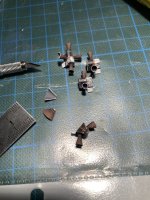Hi friends
Tady, my aging eyes spotted a broken corner on my td-125's plexiglass(?) cover. This is quite a common damage it seems.
I‘m confident that there’s a suitable glue for it, but which one?
Acrylic glues tend to blind the material with the solvent, and I read somewhere elese that epoxi isn’t good either?
Tady, my aging eyes spotted a broken corner on my td-125's plexiglass(?) cover. This is quite a common damage it seems.
I‘m confident that there’s a suitable glue for it, but which one?
Acrylic glues tend to blind the material with the solvent, and I read somewhere elese that epoxi isn’t good either?
Who are you kidding that your eyes are aging? 😉
If the area of damage is so small that you've only just noticed it, it may be wise just to leave well enough alone!
If it is an acrylic lid, then a recommended bonding agent is chloroform.
This link mentions repairing a lid for a Thorens turntable using chloroform (read to the bottom of the link):
https://www.tnt-audio.com/clinica/lidrepair_e.html
DISCLAIMER: I have not tried this myself!
If the area of damage is so small that you've only just noticed it, it may be wise just to leave well enough alone!
If it is an acrylic lid, then a recommended bonding agent is chloroform.
This link mentions repairing a lid for a Thorens turntable using chloroform (read to the bottom of the link):
https://www.tnt-audio.com/clinica/lidrepair_e.html
DISCLAIMER: I have not tried this myself!
Ah, wow, this is cool! Have to figure out wether it is acrylic or not. Will report back after research was done after a bit of further procrastination 😉
As for the kidding part, that was an attempt to use irony to obfuscate the fact that I ignored it until now. The crack is not yet making the lid unusable, but jt will if I continue to ise it as it is…
As for the kidding part, that was an attempt to use irony to obfuscate the fact that I ignored it until now. The crack is not yet making the lid unusable, but jt will if I continue to ise it as it is…
With good ventilation, chloroform may not knock you out. (The instant-action in the old melodramas was exaggerated.) However it is now suspected of causing cancer. Also nasty gas when exposed to flame. And as always, you can use it with criminal intent.
The US online shops I found say stuff like "This item is sold and shipped to educational institutions only by phone. Not available for online purchases or shipping to residential addresses."
The US online shops I found say stuff like "This item is sold and shipped to educational institutions only by phone. Not available for online purchases or shipping to residential addresses."
Plastic specialist sites:
https://craftknights.com/how-to-glue-plexiglass-choosing-the-right-type-of-glue/
https://www.eplastics.com/accessories/plastic-adhesives/acrylic-glue
They probably have a page telling how to test your plastic for type. Each burns a little different; there are preliminary tests which may give an answer before you breathe toxic smoke.
https://craftknights.com/how-to-glue-plexiglass-choosing-the-right-type-of-glue/
https://www.eplastics.com/accessories/plastic-adhesives/acrylic-glue
They probably have a page telling how to test your plastic for type. Each burns a little different; there are preliminary tests which may give an answer before you breathe toxic smoke.
Since no cracks, breakages [yet] IME, FYI/FWIW/YMMV: https://www.google.com/search?q=bon...9i57j69i58.15474j0j4&sourceid=chrome&ie=UTF-8
It seems it’s the brain, not the eyes (although…)Who are you kidding that your eyes are aging? 😉
Only now I realize the pun…
Attachments
Chloroform can be dribbled with a glass syringe for solvent bonding acrylic..
It can leave marks, use sparingly.
Try on scrap first to practice.
PVC pipe cement is mostly acrylic dissolved in solvent, that may work.
Safer and easier to obtain than chloroform.
If dextrous, try a super glue.
If it is due to ageing, the better way is to stress relieve acrylic at 75 to 80 C for two hours in a circulating fan type oven, gradually cool later.
Then repair with chloroform or clear epoxy.
It might be Poly carbonate, which does not do this after years, it happens there in two three years.
Simple test, tap it with your fingernail, flat side, as if playing the drums with them.
If the sound is sharp, it is Styrenic, most likely acrylic.
If dull, it is most likely Poly carbonate.
Very unlikely to be cast resin (those do not crack)
It can leave marks, use sparingly.
Try on scrap first to practice.
PVC pipe cement is mostly acrylic dissolved in solvent, that may work.
Safer and easier to obtain than chloroform.
If dextrous, try a super glue.
If it is due to ageing, the better way is to stress relieve acrylic at 75 to 80 C for two hours in a circulating fan type oven, gradually cool later.
Then repair with chloroform or clear epoxy.
It might be Poly carbonate, which does not do this after years, it happens there in two three years.
Simple test, tap it with your fingernail, flat side, as if playing the drums with them.
If the sound is sharp, it is Styrenic, most likely acrylic.
If dull, it is most likely Poly carbonate.
Very unlikely to be cast resin (those do not crack)
I have good experience with the Pattex Plastix, widely available in most DIY stores here. I think it's a close cousin of the Loctite Plastic Bonding System: same parent. Just beware it's very liquid, so apply sparingly.
Chloroform works very well, that was what we used in a model shop doing architectural models when i was younger. Use a small brush, We used to have a small press dispenser that would top just a few drops but i can't find the name of it nor images. It does not really matter as you will not spend your whole day glueing, just keep the place well ventilated. Not sure how easy it is to obtain?
- Home
- Design & Build
- Construction Tips
- TD125 dust-cover: can it be fixed?
